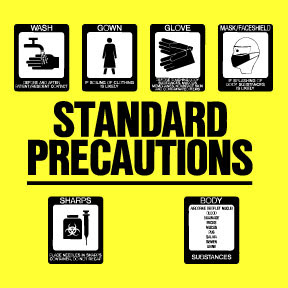FON: Standard Precautions

Standard Precautions: Tier 1 Perform hand hygiene before and after care and when soiled; most important way to prevent infection Use personal protective equipment (PPE) if touching, spilling, or splashing of blood or body fluids is likely; use gloves, gowns, mask, goggles, shields, aprons, head and foot protection Discard disposable items in fluid-impermeable bag and contaminated Do not recap used needles; dispose in sharps container Hold linen away from body; place in impermeable bag in a covered hamper; do not let hampers overflow Place lab specimens in a leak-proof transport bag without contaminating the outside; label with biohazard sticker and patient information Institute procedure for accidental exposure: Wash area, report to supervisor, receive emergency care, seek referral for follow-up Receive hepatitis B vaccine Assign patient to private room if hygiene practices are unacceptable Avoid eating, drinking, touching eyes, apply...
